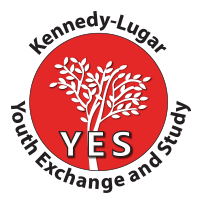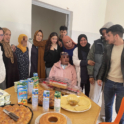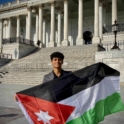Photo: Bassel from Lebanon demonstrates the washing before prayer, called wudu
This article was originally published in the Washington Post
by Tara Bahrampour, Washington Post
On a balmy November night, a busload of eighth-graders spilled out onto Massachusetts Avenue NW, the girls tentatively pulling on head scarves they had been instructed to bring.
“Does mine look normal?” one asked, cinching it tightly under her chin.
“Mine looks really ugly, doesn’t it?” said another, tugging at a billowy confection of material.
Suitably attired, more or less, they trooped into the Islamic Center of Washington, D.C. Many of the students, who belong to an after-school Hebrew program at Congregation Beth El in Bethesda, had passed by the large mosque with the columns and minaret, but they had never gone inside, until now.
The youths are part of a cultural exchange between Beth El and AFS Intercultural Programs (formerly the American Field Service), which brings teenagers from all over the world to live with host families in the United States and sends American teens abroad.
For the program, in its fourth year, eight foreign students being hosted in the Washington area were teaching the Beth El students about Islam, the religion of four of the exchange students; Hinduism, the faith of two of the students, was added this year.
The students — from Indonesia, Lebanon, Yemen, Egypt, Armenia, India and Germany — are here on State Department scholarships and had visited Beth El last month to give a classroom presentation. Later in the month, the Beth El students joined them on field trips to a mosque and a Hindu temple.
Inside the mosque, the girls and boys removed their shoes and were separated in different rooms. Cucut Syati, 16, a student from Indonesia wearing a purple satin tunic, showed the girls the elaborate pre-prayer washing ritual — hands, mouth, nose, face, arm, head, ears and feet.
The idea is “to make sure we’re sort of like in the right position to meet our God,” she said. “Maybe you said something bad, maybe you smelled something bad, maybe you heard something bad, maybe you did something wrong with your right or left hand” — water purifies the body, she explained.
She demonstrated how she fastens her own head scarf — with pins — then modeled her prayer headdress, a toothpaste-green affair. “It’s funny looking?” she said with a grin. “It’s really good for Halloween, actually — you can be a ghost.”
In the soaring central room, decorated with gold calligraphic and geometric patterns, Bassel Chokr, 16, of Lebanon and Khaled Abdulghaffar, 17, of Yemen demonstrated Muslim prayers and debunked myths about Islam.
The Beth El kids had questions: What if you don’t know which way to face when you’re praying? What if you forget to pray? If you’re in Mecca, which way do you pray toward?
Bassel handed out 1,000-lire bills from Lebanon (worth about 66 cents), and Ahmed Sadek, 17, of Egypt used a pad of papyrus to write out Beth El students’ names in Arabic.
“Mosques aren’t too shabby,” said Abe Kuhn, 13, one of the Beth El students.
Two weeks later, the groups met again at the International Society for Krishna Consciousness temple in Potomac. In a marble-floored room perfumed by incense, the boys and girls sat before statues of the Hindu god Krishna and his monkey servant, Hanuman, bedecked in elaborate outfits with flower garlands.
Dressed in saris, Drashti Wani, 16, and Surbhi Kaul, 17, both of India, explained that different Hindu temples are dedicated to different gods. They spoke of the concept of reincarnation and described the food offerings made to the gods.
Here, too, the Beth El students had questions: Do you have a lot of chocolate in your culture? Do you do different things when you worship different gods? Can you marry in Hinduism? (Drashti giggled. “Yes, we do.”)
